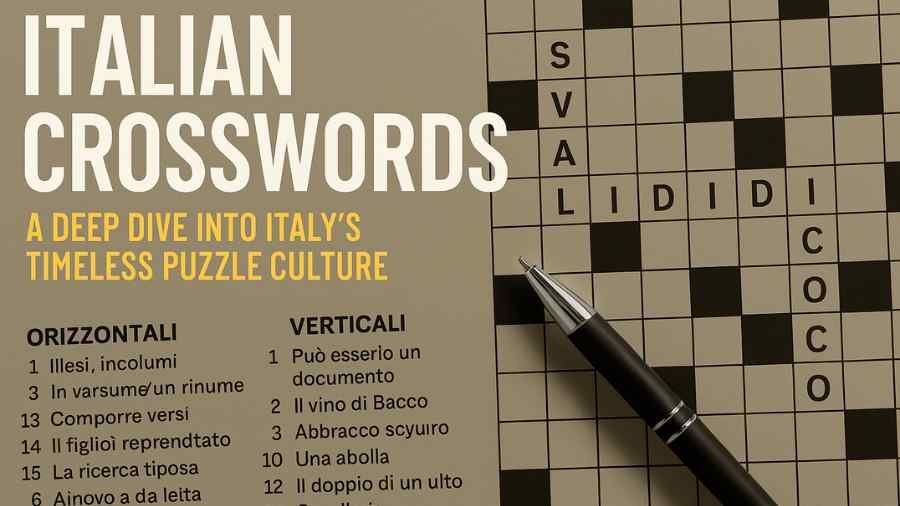Italian Crosswords: A Deep Dive into Italy’s Timeless Puzzle Culture

Italian crosswords, known locally as cruciverba or parole crociate, hold a special place in the rich tapestry of Italian culture. They are more than just word puzzles; they are a reflection of language, wit, and intellect deeply intertwined with the nation’s literary and social traditions. Unlike the modern digital games that dominate screens today, Italian crosswords continue to embody a nostalgic charm — a link between generations who have delighted in the art of words and reasoning.
To an Italian, solving a crossword is not merely a pastime; it is an act of mental refinement, linguistic appreciation, and even social connection. Whether found in the classic pages of La Settimana Enigmistica or in contemporary puzzle apps, Italian crosswords continue to evolve while preserving the timeless elements that make them both challenging and beautiful.
The Origins of Italian Crosswords
The first Italian crossword appeared on 14 September 1890 in Il Secolo Illustrato della Domenica, a popular magazine of that era. The puzzle was quite simple — a small 4×4 grid — yet it marked the birth of an enduring national fascination. Inspired by early forms of word puzzles emerging from England and the United States, Italians adapted the format to their own language and cultural context, creating something uniquely expressive.
By the 1930s, crosswords had become an integral part of Italian leisure life. The launch of La Settimana Enigmistica in 1932 transformed the trend into a cultural institution. This weekly publication, still running strong today, became synonymous with Italian crossword culture. It was a magazine that Italians carried on trains, read during coffee breaks, and shared among friends.
What made Italian crosswords particularly distinctive was their combination of linguistic precision and poetic clues. Unlike some English puzzles that focus on cryptic hints, Italian crosswords emphasise the elegance of vocabulary and cultural knowledge. They often included references to literature, geography, art, and even regional dialects — reflecting Italy’s deep connection to language and history.
Structure and Style of Italian Crosswords
Italian crosswords are similar in structure to other Western crosswords, but they often possess unique characteristics. Each puzzle consists of a grid divided into black and white squares. Words are written both horizontally (orizzontali) and vertically (verticali), with intersecting letters forming clues for both directions.
Clues (definizioni) are listed separately for horizontal and vertical entries. They can range from straightforward vocabulary-based hints to complex wordplays that test knowledge of idioms, synonyms, and general culture. Some puzzles even include abbreviations, ancient terms, or historical names, demanding not only language skills but also intellectual curiosity.
Moreover, Italian crosswords are categorised by difficulty levels. Easy puzzles often use common words and familiar topics, while advanced ones, known as enigmistici di livello alto, may incorporate literary expressions, regional proverbs, or even Latin roots. This diversity ensures that both beginners and experts can find suitable challenges.
The Cultural Significance of Crosswords in Italy
Crosswords in Italy are much more than mere word games; they are part of the nation’s cultural identity. Italians see them as a way to stimulate the mind, maintain linguistic sharpness, and engage with the Italian language in a playful yet disciplined manner.
Older generations particularly associate crosswords with daily routines. A folded puzzle magazine next to an espresso cup in a café is a familiar sight across the country. It symbolises relaxation, reflection, and intellectual exercise. For many, solving a crossword on a Sunday morning remains a ritual as traditional as a family lunch.
Schools and universities have also adopted crosswords as educational tools. Teachers use them to enhance vocabulary, improve spelling, and promote logical reasoning among students. By turning learning into an enjoyable challenge, Italian crosswords have become a bridge between education and entertainment.
Even linguists appreciate their role in preserving the richness of the Italian language. Through the decades, crossword clues have captured idiomatic expressions, literary references, and forgotten terms, effectively documenting how the language has evolved. In that sense, crosswords act as informal linguistic archives.
The Golden Age of La Settimana Enigmistica
If there is one publication that defines Italian crossword culture, it is La Settimana Enigmistica. Founded in 1932 by journalist and publisher Stefano Ponzoni, it revolutionised how Italians interacted with puzzles. Each issue was carefully designed to challenge, entertain, and educate its readers.
The magazine introduced some of the most iconic crossword creators, including Piero Bartezzaghi, whose puzzles became legendary for their sophistication. Solving a Bartezzaghi crossword became a mark of intellectual achievement, almost a cultural badge of honour.
Beyond crosswords, the magazine featured riddles, rebuses, anagrams, and logic games — nurturing an entire generation of puzzle enthusiasts. To this day, La Settimana Enigmistica remains a household name, respected for its quality, consistency, and tradition.
Italian Crosswords in the Digital Era
In the twenty-first century, digital transformation has reshaped how Italians engage with crosswords. What once required a printed magazine is now accessible through smartphones, tablets, and online platforms. Yet, the essence remains unchanged.
Modern apps such as Cruciverba Italiano and Parole Crociate Online allow users to choose from various difficulty levels, compete on leaderboards, and even receive hints. Online communities dedicated to enigmistica discuss puzzle strategies, share rare grids, and celebrate the craft of constructing crosswords.
Interestingly, technology has not diminished the traditional love for print editions. Many Italians still prefer solving crosswords with a pen on paper. The tactile experience, the satisfaction of filling each square, and the physical connection to the puzzle evoke nostalgia and focus that digital devices cannot fully replicate.
Educational and Cognitive Benefits
Numerous studies highlight the cognitive benefits of crossword-solving, and Italians have long embraced these advantages. Regularly engaging with cruciverba enhances memory, sharpens reasoning, and improves linguistic agility. It keeps the brain active, which can help delay cognitive decline associated with ageing.
For learners of Italian, crosswords are a fun and effective way to build vocabulary. They expose solvers to verb conjugations, idioms, and grammatical nuances in context. Many teachers and language learners use Italian crosswords as a supplementary tool to reinforce comprehension and fluency.
Moreover, the act of solving puzzles nurtures patience, focus, and problem-solving skills — qualities valued both academically and professionally. It encourages the mind to think laterally, connecting words and ideas creatively.
The Art of Creating Italian Crosswords
Constructing an Italian crossword is itself an art form. Puzzle makers, known as enigmisti, spend hours designing symmetrical grids, selecting suitable vocabulary, and crafting clues that are both fair and engaging.
A well-constructed Italian crossword balances clarity and challenge. The best constructors manage to make solvers think deeply without feeling overwhelmed. Every word and definition must fit perfectly within the linguistic structure of Italian, which has its own complexities of gender, plural forms, and verb endings.
Piero Bartezzaghi once said that creating a crossword is like composing music — every letter must harmonise with others. This philosophy continues to inspire new generations of enigmisti, who blend traditional craftsmanship with modern technology.
The Social Aspect of Italian Crosswords
While crossword-solving can be a solitary activity, in Italy it often carries a social dimension. Families may gather around a newspaper to solve a puzzle together, each contributing a clue. Friends might challenge each other to finish a difficult grid faster.
In cafés, especially in small towns, it is common to see groups discussing clues aloud, debating word meanings, and laughing over tricky definitions. This communal spirit reflects Italy’s broader culture of conversation, wit, and shared intellect.
Online, crossword enthusiasts form communities on forums and social media where they exchange advice and celebrate clever solutions. These digital gatherings keep the culture of enigmistica alive and connected across generations.
The Future of Italian Crosswords
Despite the fast pace of modern life, Italian crosswords show no sign of fading. In fact, they are experiencing a quiet renaissance. Publishers are releasing new collections, educational platforms are adopting them for language training, and young people are rediscovering their charm through apps and competitions.
Artificial Intelligence has also entered the field. Researchers are experimenting with AI models that can generate crosswords automatically or suggest clues based on linguistic databases. However, many purists believe that human creativity will always remain essential in crafting puzzles that carry humour, elegance, and depth.
The enduring popularity of Italian crosswords lies in their perfect balance between intellect and entertainment. They are puzzles that celebrate the beauty of language and reward perseverance, creativity, and cultural knowledge.
Conclusion
Italian crosswords, or cruciverba, are more than word puzzles — they are a cultural tradition that embodies Italy’s love for language, logic, and artistry. From their modest beginnings in the nineteenth century to their prominent place in today’s digital world, they have connected generations of Italians through words and wit.
Whether solved alone in quiet reflection or shared among friends over coffee, Italian crosswords remind us that language is both a game and a gateway to understanding. Their enduring appeal proves that, even in an age dominated by technology, the charm of the written word — arranged thoughtfully within a simple grid — remains timeless.



